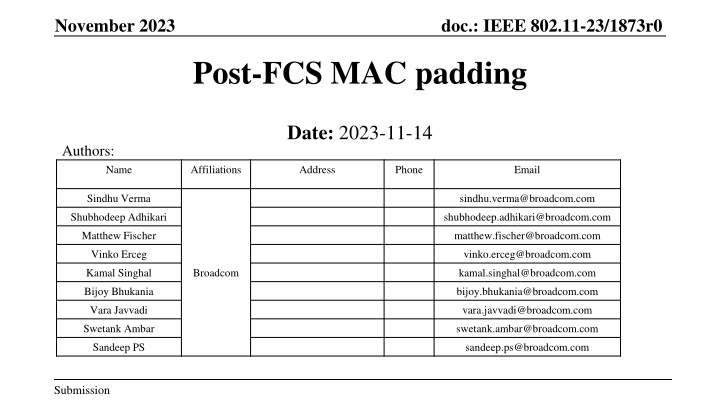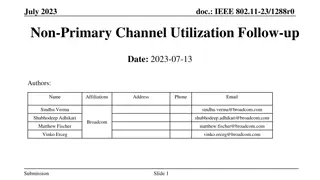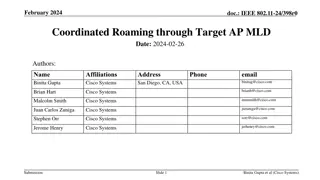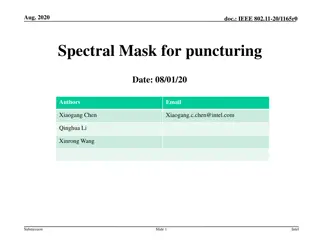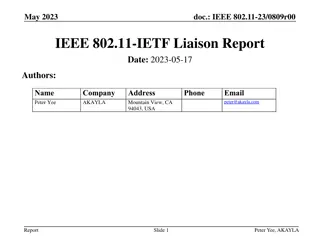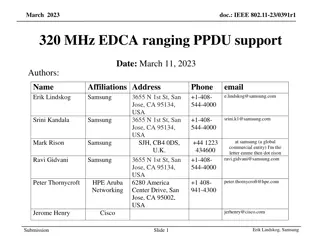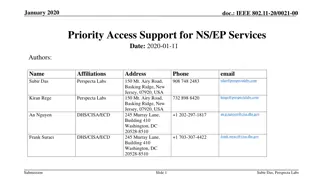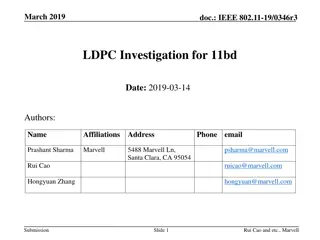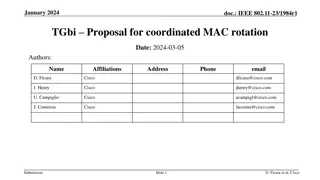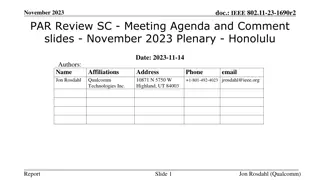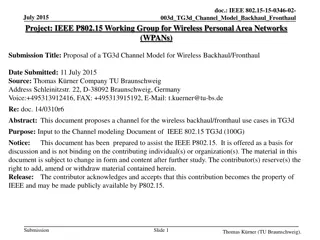Introduction to IEEE 802.11-23/1873r0 November 2023 Proposal
This contribution addresses the introduction of post-FCS MAC padding for 802.11bn, discussing the necessity and methods involved. The document outlines the problem statement, current provisions for padding, limitations of existing mechanisms, and implications for various operations in the IEEE 802.11 standards. It delves into the significance of padding in enhancing transmission efficiency and accommodating diverse scenarios within the wireless communication framework.
Download Presentation

Please find below an Image/Link to download the presentation.
The content on the website is provided AS IS for your information and personal use only. It may not be sold, licensed, or shared on other websites without obtaining consent from the author.If you encounter any issues during the download, it is possible that the publisher has removed the file from their server.
You are allowed to download the files provided on this website for personal or commercial use, subject to the condition that they are used lawfully. All files are the property of their respective owners.
The content on the website is provided AS IS for your information and personal use only. It may not be sold, licensed, or shared on other websites without obtaining consent from the author.
E N D
Presentation Transcript
doc.: IEEE 802.11-23/1873r0 November 2023 Post-FCS MAC padding Date: 2023-11-14 Authors: Name Affiliations Address Phone Email Sindhu Verma sindhu.verma@broadcom.com Shubhodeep Adhikari shubhodeep.adhikari@broadcom.com Matthew Fischer matthew.fischer@broadcom.com Vinko Erceg vinko.erceg@broadcom.com Kamal Singhal Broadcom kamal.singhal@broadcom.com Bijoy Bhukania bijoy.bhukania@broadcom.com Vara Javvadi vara.javvadi@broadcom.com Swetank Ambar swetank.ambar@broadcom.com Sandeep PS sandeep.ps@broadcom.com Submission
doc.: IEEE 802.11-23/1873r0 Abstract This contribution discusses the requirement and method to introduce a post-FCS MAC padding for 802.11bn Submission Slide 2
doc.: IEEE 802.11-23/1873r0 Problem Statement Padding has been conventionally required in 802.11 for the following cases: To stretch the occupancy of a DL/UL transmission to the end of a symbol In case of a DL/UL MU transmission, to align the end times of individual A- MPDUs corresponding to multiple STAs To provide a time margin for processing a PPDU, especially its last symbol In case of 802.11be, padding is also used to provide for switching delays in EMLSR and EMLMR as well as to align transmission of PPDUs over multiple links 802.11bn is considering several schemes like Non-Primary Channel Access, Power Save, Dynamic Subband Operation and enhanced In-Device-Coexistence which may need delay allowances through padding for adapting to different channels or subbands. Submission Slide 3
doc.: IEEE 802.11-23/1873r0 Current Provisions for Padding MAC padding in a single MPDU Pre-FCS PHY padding in an HE PPDU Packet extension (up to 16us) Post-FCS padding (limited by symbol length) Padding through a null MPDU in an A-MPDU HT and later PPDUs can carry an AMPDU the last of which can be a null MPDU Padding with NULL Delimiters in an A-MPDU Submission Slide 4
doc.: IEEE 802.11-23/1873r0 Limitations of current padding mechanisms (1) Limitations of current MAC padding It is pre-FCS for every MPDU In case of non-HT PPDUs, this pre-FCS MAC padding is the only way to provide for switching delays for various operations like EMLSR/EMLMR in 802.11be and Non-Primary Channel Access, Power Save, enhanced IDC and Dynamic Subband Operation being proposed for UHR If the switching frames for such features are in non-HT duplicate format, pre- FCS padding still requires any receiver to decode up to the FCS to confirm the validity of the frame and to send an acknowledgement. This means that all the actions corresponding to such a frame cannot be started before the decode of FCS and hence, cannot utilize the padding optimally. Submission Slide 5
doc.: IEEE 802.11-23/1873r0 Limitations of current padding mechanisms (2) Limitations of current PHY padding Even though the PHY padding (possible HE onwards) is post FCS, it is limited in duration and can only provide for delay requirements bounded by about 20us If a UHR PPDU is defined which allows for higher duration of PHY padding, the MAC duration will not be interpreted by pre-UHR devices Further, such a padding possible in only a UHR PPDU will also not be usable for features like EMLSR/Non primary channel access/Dynamic Subband Operation/Power Save/enhanced IDC etc that may require padding in non-HT duplicate format that is repeated every 20MHz Submission Slide 6
doc.: IEEE 802.11-23/1873r0 Limitations of current padding mechanisms (3) Limitations of padding through a null MPDU in an AMPDU or NULL Delimiters This is not possible in a non-HT duplicate PPDU as an AMPDU cannot be transmitted in a non-HT duplicate PPDU This implies that it is not usable for features like EMLSR/NPCA/DSO/Power Save/ enhanced IDC that may require padding in non-HT duplicate format that is repeated every 20MHz NULL delimiters: Encountering 1 NULL delimiter does not guarantee the ensuing part of the AMPDU consists of only NULL delimiters. Without this interpretation, the device cannot skip decoding the rest of the AMPDU and use the duration for operations like switching link/bandwidth Submission Slide 7
doc.: IEEE 802.11-23/1873r0 A proposed solution for post-FCS MAC padding (1) Define a MAC frame format that accommodates post-FCS MAC padding The UHR FCS i.e. the FCS meant for UHR reception is included at the end of the meaningful bits of the UHR MAC frame. This UHR FCS is of the same length as the regular FCS The position of this UHR FCS is indicated as a MAC header field visible to only UHR devices. Alternately, an existing subfield such as the last User Info in a Trigger frame can be modified with specific values which will be ignored by legacy devices but interpreted by UHR devices to be the UHR FCS. The UHR receiver decodes the frame only until this UHR FCS and ignores the trailing bits, if any, in the frame. The trailing bits are utilized as padding for any switching delay The trailing bits end in a conventional FCS which is of relevance to pre-UHR devices. This means that this padding scheme is compatible with pre-UHR devices Since it is a MAC frame format, it can be transmitted in a non-HT duplicate format Submission Slide 8
doc.: IEEE 802.11-23/1873r0 A proposed solution for post-FCS MAC padding (2) Additional details: Whether the post-FCS MAC padding or rather pre-MAC padding FCS is applicable to only certain frames like MU-RTS, BSRP and other candidate initial frames for DSO, Power Save, enhanced IDC, etc It is sufficient to support this feature only for specific frames that serve as initial frames that provision switching delays and elicit response for initiating the operation of certain features like EMLSR/DSO/Power Save/enhanced IDC Whether the UHR FCS for should be per user in a frame addressing multiple users or per frame A per user UHR FCS of 4 bytes entails additional overhead which defeats the purpose of introducing this which is to optimize delays A per user UHR FCS which is shorter, say of 2 bytes and overloads existing fields in the frame but allows the addressee to validate its part with just 2 bytes will result in asymmetry with respect to legacy devices which use 4-byte FCS. It will introduce a higher probability of error and resulting higher probability of medium occupancy despite the error. Submission Slide 9
doc.: IEEE 802.11-23/1873r0 Benefits of the proposed solution for post-FCS MAC padding Can be used for efficient EMLSR/EMLMR switching delay where the initial transmission is in non-HT duplicate format and hence, decodable over 20MHz. The receivers can fully commit to the switch from listen to receive mode after decoding the UHR FCS without having to decode the FCS at the end of the frame and hence, without any false switches Can be used for Single Link and Multi link Power Save where the initial reception can be only over 20MHz and hence, use much lower power. After decoding the UHR FCS, the receiver can expand its bandwidth capability during the post-FCS MAC padding. Can be utilized for Dynamic Subband Operation where the receiver can start switching to the indicated subband immediately after decoding the UHR FCS Can also be useful for Non-Primary Channel Access where a recipient is listening for preamble on multiple channels and may need to switch to a data reception mode after receiving the initial frame. Submission Slide 10
doc.: IEEE 802.11-23/1873r0 Conclusion Padding is crucial to provide the necessary and variable delay allowances required for various features in legacy 802.11 as well as in UHR The currently available forms of padding in 802.11 have limitations in specific use cases The proposed solution to introduce a post-FCS MAC padding or rather pre-MAC padding FCS for UHR has benefits in numerous use cases ranging from EMLSR, EMLMR, NPCA, DSO and Power Save. It is also compatible with pre-UHR devices and does not impact them adversely Submission Slide 11
doc.: IEEE 802.11-23/1873r0 Straw Poll 1 Do you agree to define a way to include in an initial control frame, one intermediate FCS for UHR STA(s) that precedes padding and the regular/legacy FCS Y/N/A Submission Slide 12
doc.: IEEE 802.11-23/1873r0 Reference [1] IEEE P802.11be /D5.0 Submission Slide 13
